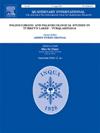南非豪登省人类摇篮地区早更新世Cooper’s D地区的大中型Glires(啮齿类和Lagomorphs)
IF 1.9
3区 地球科学
Q3 GEOGRAPHY, PHYSICAL
引用次数: 0
摘要
中型哺乳动物(即中等体型的哺乳动物)的遗迹在非洲南部的化石遗址中随处可见。尽管中型哺乳动物在分类学上并不构成一个具有凝聚力的类群,但它们具有共同的生态特征,并经历类似的岩石学过程,因此对于了解过去的生态系统至关重要。本研究的重点是人类摇篮库珀洞穴早更新世人类居住遗址中的中型和大型啮齿类动物的颅齿遗骸以及蜥脚类动物的颅齿遗骸。库珀D沉积物的年代大约为1.4Ma,它提供了丰富的动物材料,包括许多中型哺乳动物遗骸。这篇论文对化石材料进行了最新的分类分析,包括带有新诊断标准的形态描述、不同类群的生态信息以及初步的岩石学观察。值得注意的是,这批化石记录了南非已知最古老的 Geosciurus 属,将其存在的时间向前推了 100 多万年。本文章由计算机程序翻译,如有差异,请以英文原文为准。
Medium and large-sized Glires (Rodents and Lagomorphs) from the early Pleistocene Cooper's D locality in the Cradle of Humankind, Gauteng, South Africa
Remains of mesomammals, i.e. intermediate-sized mammals, are ubiquitous in southern African fossil sites. Even though they do not constitute a taxonomically cohesive group, medium-sized mammals share common ecological traits and are subject to similar taphonomic processes, making them essential for understanding past ecosystems. This study focuses on craniodental remains of medium- and large-sized rodents and lagomorphs from the Early Pleistocene hominin-bearing site of Cooper's Cave in the Cradle of Humankind. The Cooper's D deposit, dated to approximately <1.4 Ma, has provided a wealth of faunal material, including many mesomammal remains. This contribution presents an updated taxonomic analysis of fossil material, including morphological descriptions with new diagnostic criteria, ecological information about the different taxa, and preliminary taphonomic observations. Notably, this assemblage documents the oldest known occurrence of the genus Geosciurus in South Africa, pushing its attested presence back by over one million years.
求助全文
通过发布文献求助,成功后即可免费获取论文全文。
去求助
来源期刊

Quaternary International
地学-地球科学综合
CiteScore
5.60
自引率
4.50%
发文量
336
审稿时长
3 months
期刊介绍:
Quaternary International is the official journal of the International Union for Quaternary Research. The objectives are to publish a high quality scientific journal under the auspices of the premier Quaternary association that reflects the interdisciplinary nature of INQUA and records recent advances in Quaternary science that appeal to a wide audience.
This series will encompass all the full spectrum of the physical and natural sciences that are commonly employed in solving Quaternary problems. The policy is to publish peer refereed collected research papers from symposia, workshops and meetings sponsored by INQUA. In addition, other organizations may request publication of their collected works pertaining to the Quaternary.
 求助内容:
求助内容: 应助结果提醒方式:
应助结果提醒方式:


